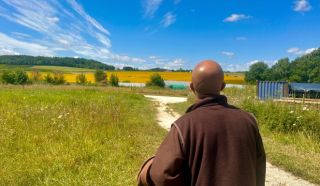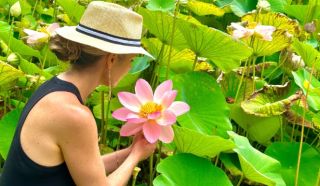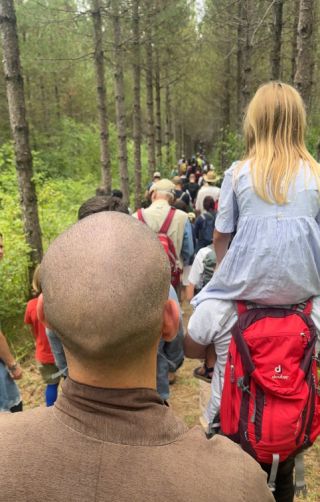Self-Help
5 Practices to Bring You Joy in the Here and Now
Personal Perspective: Don't miss out on the natural joy right before your eyes.
Posted August 10, 2023 Reviewed by Jessica Schrader

It felt nearly impossible to pull out of our busy family life and head to Plum Village Monastery in France. As is often the case, doing the impossible is what makes life magical. It’s available to you right now. Here are some of the lessons I want to share with you upon our return.
1. Look for the Path
Plum Village is full of walking paths—paths through plum orchards, aspen trees, and even tiny paths between meditation cushions. Unlike pills that may make the pain go away short-term, paths can offer a long-term solution to our suffering. We expect and crave quick fixes when we hurt, but often these fixes only worsen our pain.
In the book Buddhism Without Beliefs, Stephen Batchelor describes spiritual paths as having three beneficial qualities: direction, freedom to move, and a feeling of never being alone.
Practice at home:
- Find a path and follow it. What gives you a sense of direction? How can you move flexibly along that path? Where do you find community?

2. Wake Up and See What’s Here
The first thing I noticed when I stepped into Thich Nhat Hanh’s hermitage was his view. "Thay called this his TV," said Brother Phap Huu. He pointed to the large window overlooking orchards, rolling hills, and a dramatic blue sky with puffy white clouds. The brown hues of his hermitage made the colors pop even more.
We have the right to enjoy life even when it’s painful and uncertain. Often, we are so caught in our thoughts or distracted by wanting things to be different that we miss out on the natural joy right before our eyes.
Practice at home:
- When you wake up, watch nature’s television. Instead of turning right to your phone or ruminating in your thoughts, step outside, look out a window, and enjoy what’s here now.
3. Rethink Your Motivation
At Plum Village, I was assigned to the toilet cleaning group for service mediation. The group leader asked us to pause and consider: "What is your intention in cleaning the toilets?"
Volition, or intention, is one of the Four Nutriments in Buddhism. According to the Puttamamsa Sutta, we take in nourishment not only from edible food but also from our senses, consciousness, and wholesome volitions. As I cleaned, I lived out my intention by saying "thank you" to the people at airports, restaurants, and at home who cleaned for me.
Breathing in, I mop. Breathing out, I feel grateful. No mud. No Lotus.
Practice at home:
- Set your intention. Pick a household chore—the more dreaded, the better. Before you begin, consider the question: What is your deeper motivation for doing this? During the activity, pause from time to time and remember your aspiration.

4. Heal Our Past, in the Present
During a daily dharma talk, a sister brought out a piece of wood and pointed to the concentric rings that made up the years of the tree. She said, "If we look deeply, we can see the young tree inside the old tree. Each year tells a story."
"We are just like that," she taught.
Like a tree, you also hold your history in your body, your epigenetics, and your memories. And like a tree that grows strong healthy wood around its wounds, you can heal your hurts not by forgetting them but by embracing them.
Practice at home:
- Care for the wounds in yourself and your loved ones. Imagine creating a ring of strength, understanding, and love around the wounded parts in yourself and those you love.
5. Practice Nonviolent Resistance
When asked how we can bring home the peace we felt at Plum Village, Sister Power responded,
"Practice nonviolent, kind resistance.
Resist the mainstream of running faster and doing more.
Practice determination of slowing down.
The quality of our consciousness is moving fast in the wrong direction.
We need skillful means to train our body and mind to slow and stop."
Walking slowly, eating in silence, and resting at midday are acts of nonviolent resistance to the culture of busyness and doing more. As Dr. Rhonda Merwin described in our real play about productivity anxiety, when we slow down and check in, we can better care for ourselves and each other.
Practice at home:
- Nonviolently resist busyness. Eat mindfully. Spend the first five minutes of your meal in silence, chewing each bite 30 times, naming each piece of food as you eat it, and connecting to where the food came from. Relate mindfully. Make space to slow down and connect with people without your phone. Listen deeply and make eye contact. Move mindfully. Move your body slowly and intuitively.
To find a therapist, please visit the Psychology Today Therapy Directory.




